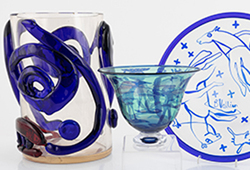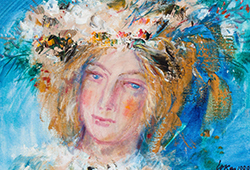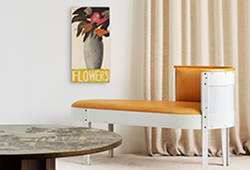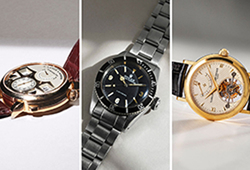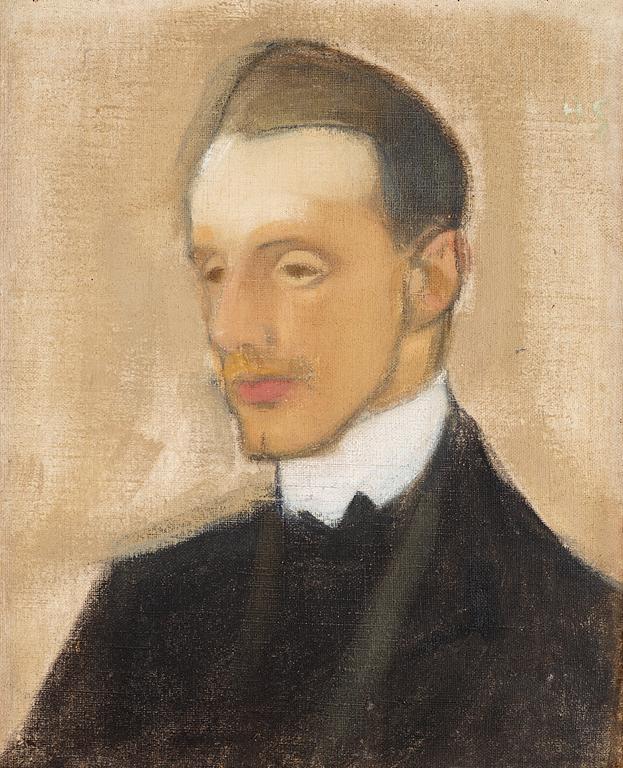Helene Schjerfbeck
"Einar Reuter (studie i brunt)" (Einar Reuter (study in brown))
Signed HS. Canvas 44,5 x 37 cm. Executed 1915-18.
Alkuperä - Provenienssi
In the private collection of Einar Reuter, thereafter within the family.
Näyttelyt
Exhibition in memory of Helene Schjerfbeck, Konsthallen, Helsinki, Finland, 1954.
Exhibition Helene Schjerfbeck, Ateneum, Helsinki, Finland, 1992.
Kirjallisuus
H. Ahtela 1953 number 431 ; Ateneum, Helsingfors 1992 number 254.
Muut tiedot
Forsmästare Einar Reuter from Tornio bought their first piece of Schjerfbeck, Vedhuggaren (1910-11) and Syskonen (1913) when an art dealer, Gösta Stenman sold his collection 1914. His interest in the artist began and he started buying her paintings and eventually took an important collection. There were insufficient for Reuter to simply collect the Schjerfbeck art. He also began writing about her and published under the pseudonym H. Ahtela several articles on Schjerfbeck and her art. His first monograph was published the same year in connection with Gösta Stenman's major retrospective exhibition of Schjerfbeck. Reuter-Ahtela real life work was still to become the comprehensive biography of Schjerfbeck, published in Finnish in 1951 and two years later in Swedish. According to Einar Reuter himself, he was for decades, the central expert of Schjerfbeck and he also became one of her closest friends.
In March 1915 Einar Reuter visited for the first time the admiring artist, who had moved with her mother to Hyvinkää in 1912. By that time, Reuter had already purchased two new paintings by Schjerfbeck, Flickan med blått band (1909) and Mediciernas dotter (1907). Schjerfbeck behaved generally quite adverse to such visits, but thought that she had found someone who understood her. She wrote to an artist friend Ada Thilén, that the Forsmästaren seemed to be a sympathetic and straightforward man well acquainted in modern art. She felt that she had met someone that she was free to discuss art with - a soul mate. Although Schjerfbeck at that time was 52 years and Reuter had turned 33 the previous autumn, the age difference where not an obstacle to their friendship.
After the first meeting was Einar Reuter’s visit the most important events in Helene Schjerfbeck life, a break in the monotonous life in Hyvinkää. They began to correspond regularly with each other, which continued until Schjerfbeck past away in 1946. Reuter’s collection was expanded gradually with a few paintings that he had received as a gift from the artist, Det röda huvudet I (1915) and Röda äpplen (1915). Schjerfbeck wanted to give these gifts to Einar Reuter as gratitude of the joy his friendship gave her, although not completely isolated in Hyvinkää, but often lacked artistic surroundings. The contact with other artists was sporadic. Not even her closest "artist sisters" like Helena Westermarck, Maria Wiik and Ada Thilén realized her interest in the early modernists, such as Henri de Toulouse-Lautrec, Paul Cezanne, Vincent van Gogh and Paul Gauguin. These artists were very familiar to Einar Reuter who during his travels in Germany and France became familiar with their art.
Schjerfbeck called Einar Reuter for a "man of the woods" because of his profession of Forsmästare and his great interest in hiking in Lapland. But Reuter was also an amateur artist whose simple way of painting showed clear influences of Schjerfbeck art. Schjerfbeck was very interested in her friend's work, and they formed together with Bernhard Häkli (who later switched to furniture), a group called Vapaa, as the years 1920 and 1924 organized two exhibitions in Helsinki. The group emerged in the Einar Reuters initiatives and also ended when his own artistic ambitions extinguished. After 1923 he painted nothing for twenty years. Einar Reuter probably gave up because of the bad reviews that Vapps received, except of course the group's "true spirit" Schjerfbeck.
For Schjerfbeck, the artistic fraternity with Einar Reuter meant enormously, and it was hard for her to accept that he gave up his career. Already in 1917, Reuter was in a difficult artistic crisis - the same year Schjerfbeck experienced a strong renessance by Gösta Stenman's solo show - and he was known to destroy many of his paintings. Schjerfbeck tried to encourage Reuter to paint, and after the civil war in 1918 they painted a few weeks together in Ekenäs. For Schjerfbeck was this experience of joint artistic life a dream that came true, couse her poor health had long limited her opportunities to travel and paint. Weeks in Ekennäs together with artist friend brought back memories of adolescence in Paris, and the photograph with Schjerfbeck in front of his easel on the park trail in Ekennäs renders an unusually bright atmosphere.
Schjerfbeck was in these times already very fond of Einar Reuter. The friend represented to her all the beautiful, wise and good in a man, as is evident also in the portrait she painted of him. One of them, conducted 1915-18, belonged to Einar Reuter's own collection. Where you particularly can notice the bright shining forehead, which seems to hide only bright and big ideas. Reuter Engagement 1919 with Tyra Art, who he met in Sweden, was a huge shock to Schjerfbeck. Her whole life seemed to derail, leading to a spiral of illness. Although Reuter later pointed out that their relationship had been "platonic", it was for Helene Schjerfbeck same question about a much deeper feeling. When the engagement had become known was the feeling more and more prominent, and the relationship between Schjerfbeck and Reuter changed. On the one hand, it lost some of its immediacy, but on the other hand, it led to a more intimate acquaintance.
Einar Reuter came from a Swedish cultural family, but went in Finnish school, was very fine-minded and wrote in Finnish. He was nevertheless fully bilingual, which was a prerequisite for friendship with Schjerfbeck, who could not speak Finnish. A dilemma arose later when Schjerfbeck could not read what Einar Reuter wrote about her in Finnish. She saw this as controversial, approved it, but was afraid of what he would write about her. As the first monograph published in 1917, and Schjerfbeck wrote to Einar Reuter and marveled at "... have you really wasted a book on me ..." To Helena Westermarck told her that the book made her nervous, but she was "grateful for his empathy”.
The articles and monographs, Reuter-Ahtela written about Schjerfbeck, became the foundation of what has long thought of her as an artist and a human being. Reuter created the myth of her as a frail and lonely hermit who lived in her own ideal of beauty isolated from real life and only lived in the art and for the arts. This image Einar Reuter gave Schjerfbeck did not match the artist's own view. She did not feel that she would have been aggrieved and accepted their fate as enshrined saint, but found instead that she lived a stormy life. Schjerfbeck struggled in general vehemently against the "spirituality" aura that they wanted to impose on her. Although her art dealer, Gösta Stenman, hade the same opinion.
Helene Schjerfbeck and Einar Reuters correspondence continued until the artist's last years in Saltsjöbaden. At the end of her life Schjerfbeck dared speak of their fundamentally different view of life because she thought that an artist's road to poverty and adversity would never have been enough for Reuter. She was really disappointed of Einar Reuter who was not the perfect artist friend, although he had been an important advocate for her art.
Text: Professor Riitta Konttinen





